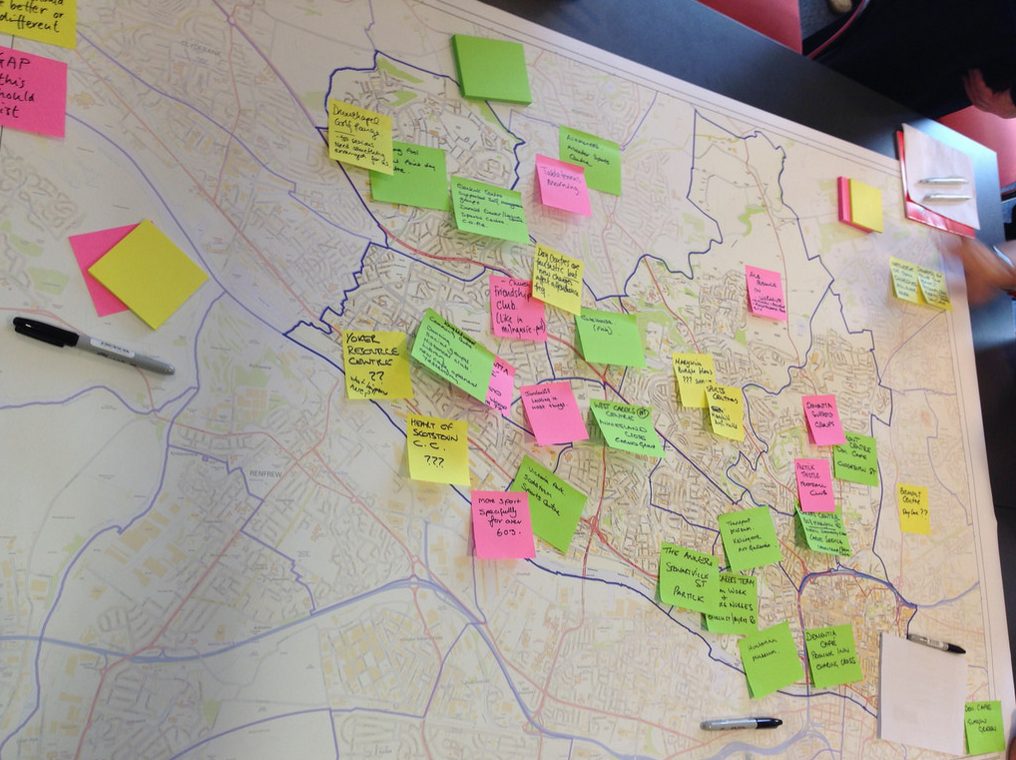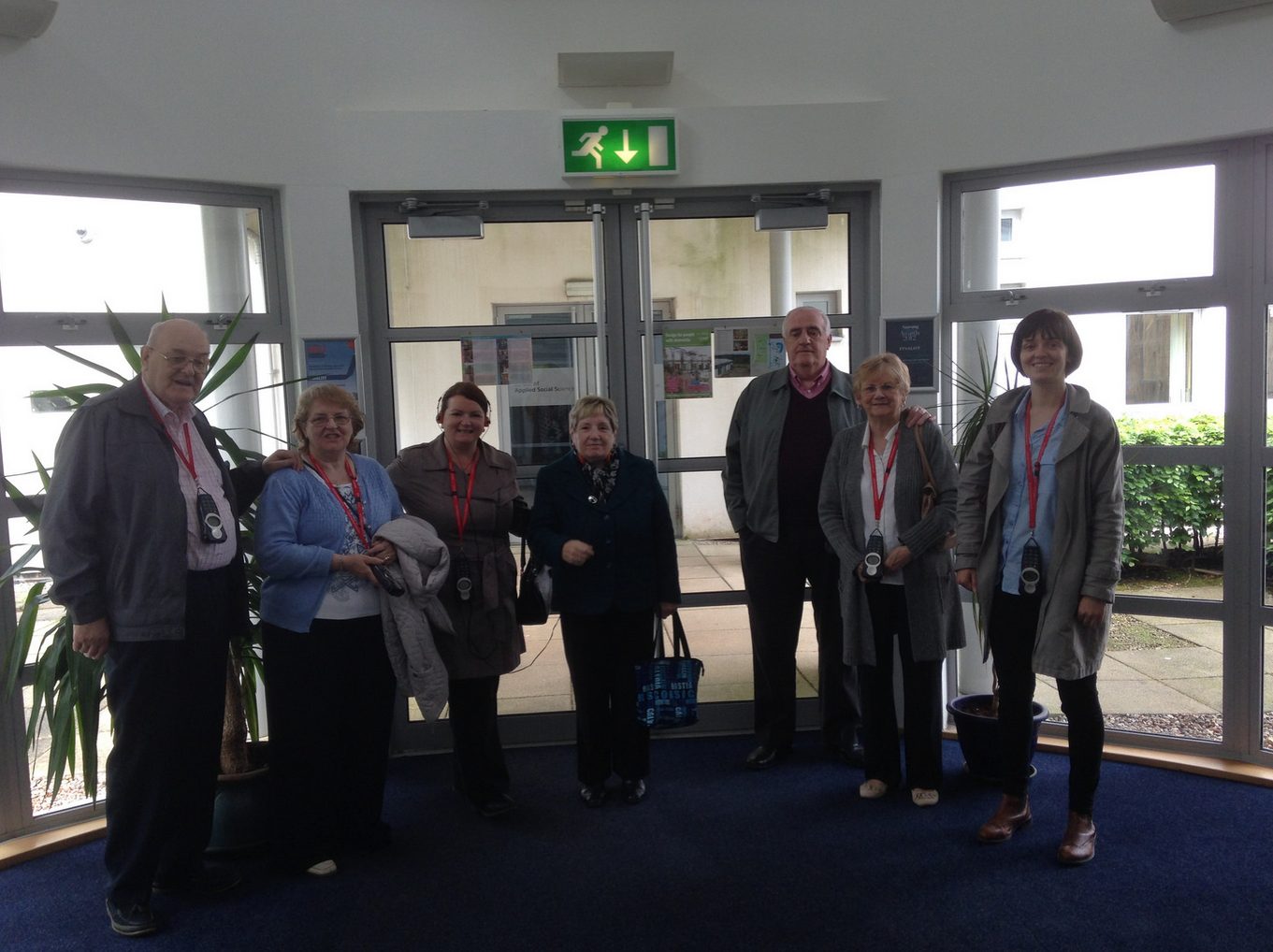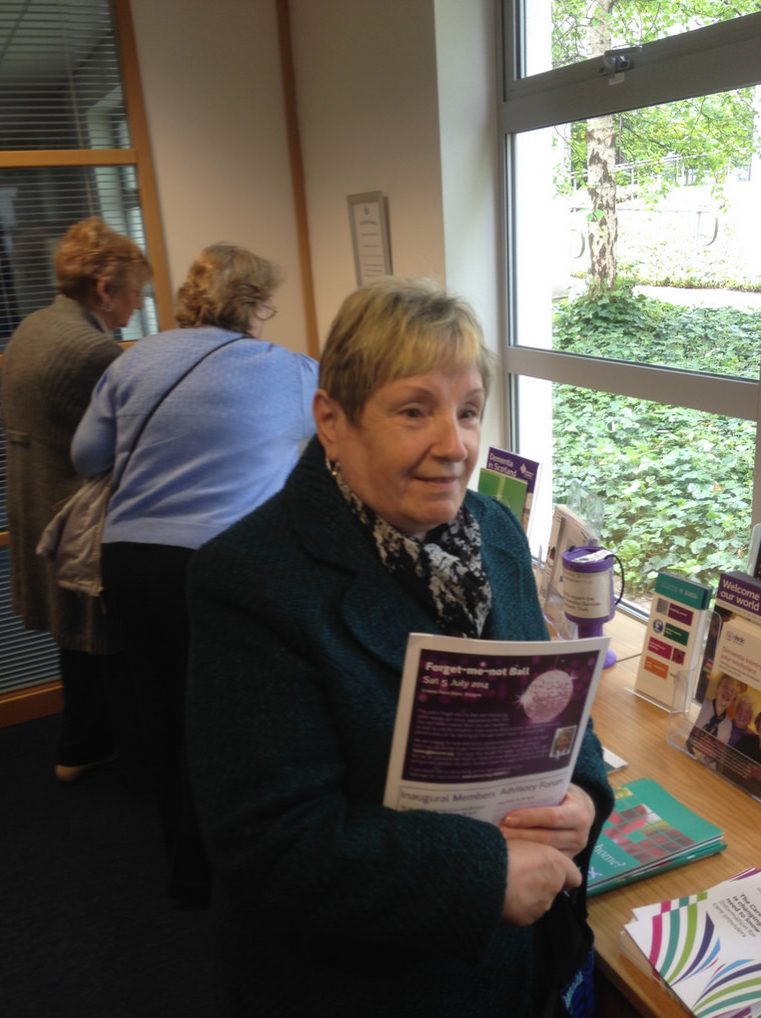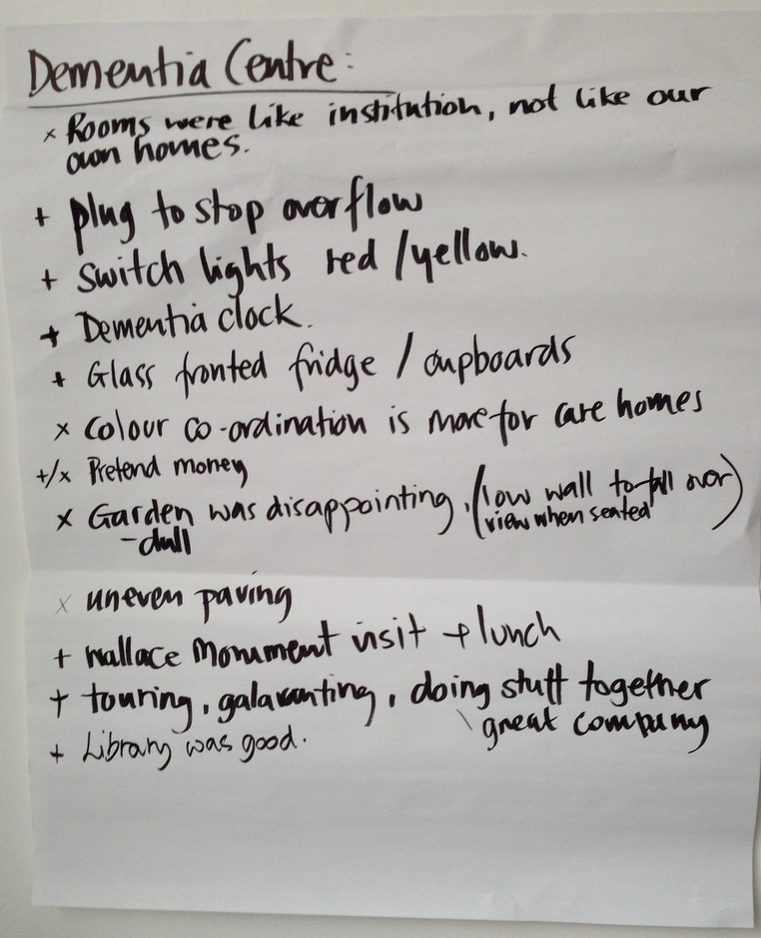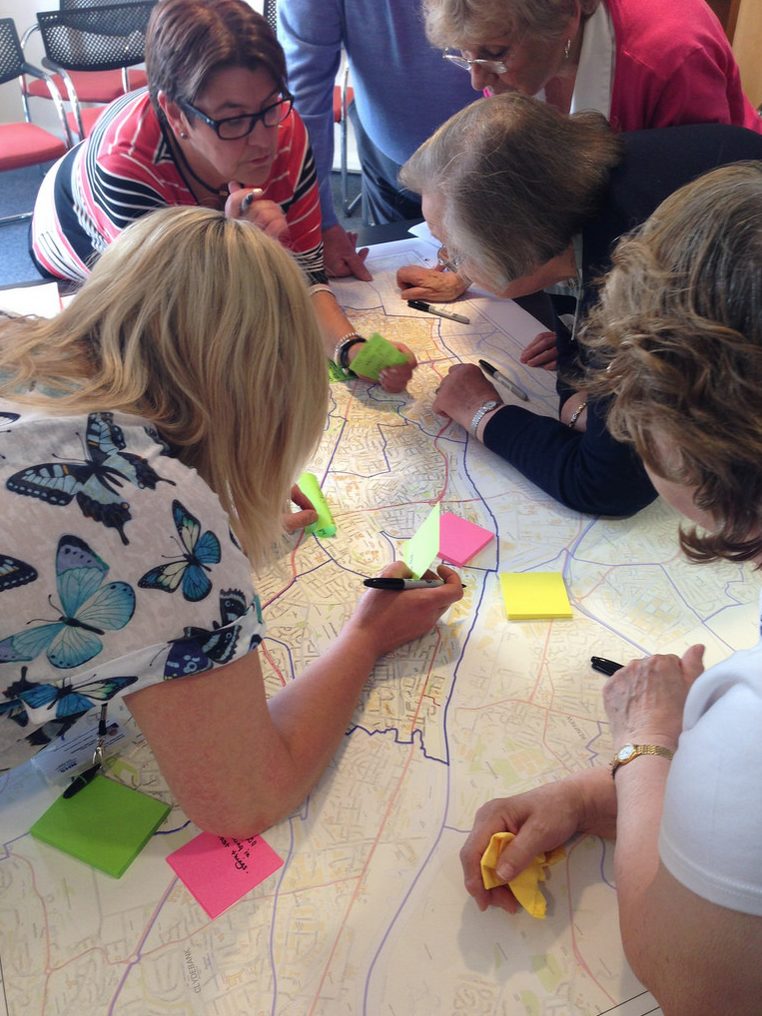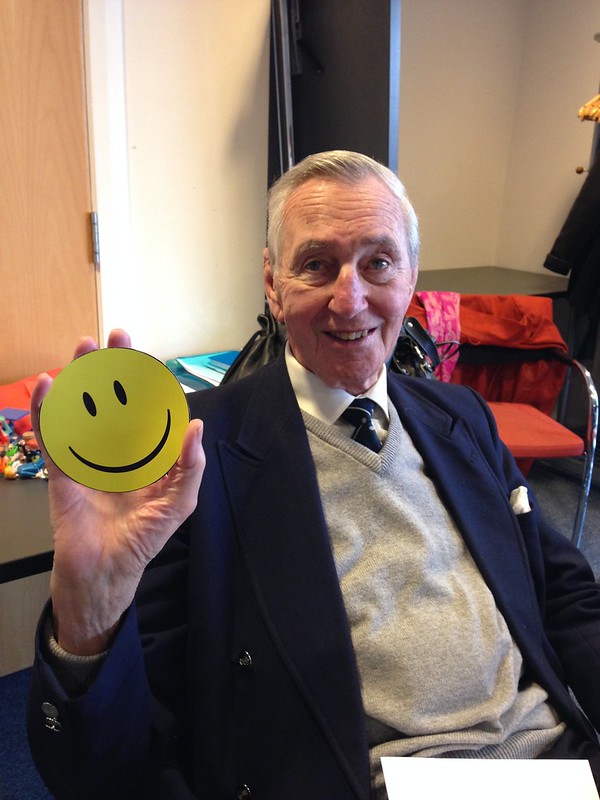Following on from understanding person-centred care and what that looks like in people’s lives, as well as our interpretations of dementia, we stayed in the understanding phase for this third workshop and thought about what kind of support there is for people with dementia in this local area.
This was our programme for the day and we decided our goals would be to:
- Revisit person-centred care and support
- Map our local assets and brainstorm improvement ideas we might take forward
- Agree homework and next steps
Connecting up – the power of positive thinking
As our ice-breaker for this meeting we asked people to speak in small groups about what keeps them strong, generally and at times of adversity, and we wrote this on the wall so we could share this amongst people in the group. People did this in groups of three before repeating with others.
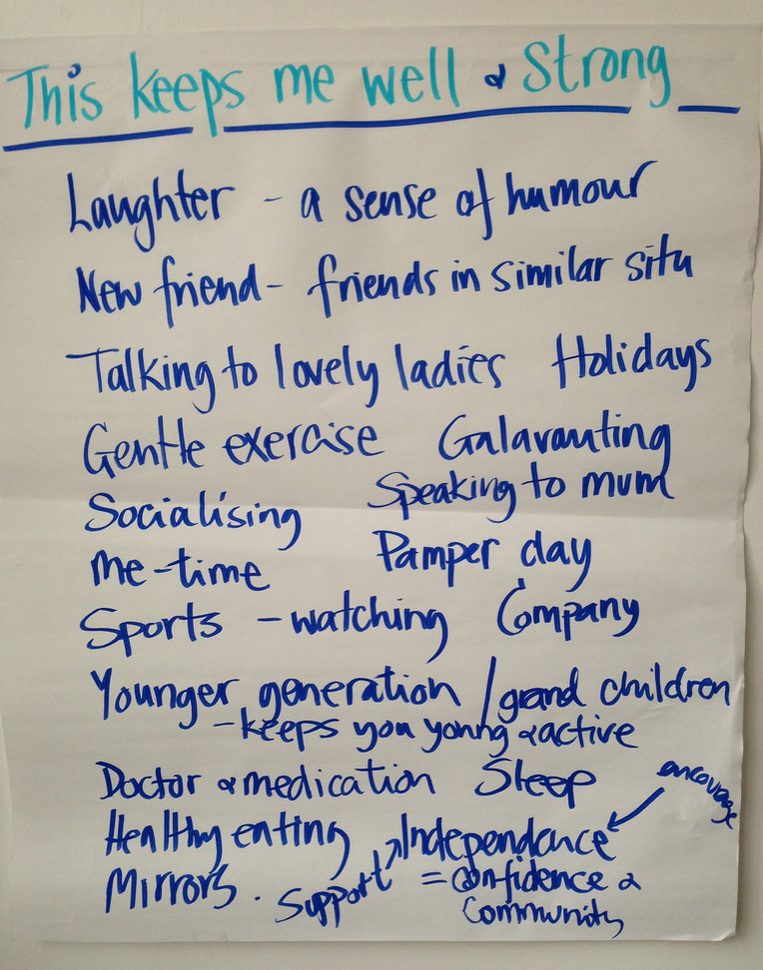 Summary of thoughts on ‘what keeps me strong’
Summary of thoughts on ‘what keeps me strong’
The group discuss what keeps them strong
Re-cap on person-centred care
Recognising the difficulty in defining person-centred care, we decided to share our own perspectives on what person-centred care means. As a starting point for this discussion we watched video clips showing the perspective of a GP and person who is managing their own health.
After watching these videos we felt it would be useful for the group to develop their own language in relation to this term, so people felt confident when using it. To assist people to think through their own definitions, we asked small groups to each devise a person-centred campaign. We set the task out as following:
Purpose of campaign:
To help people know what person-centred care and support means – and what they can reliably expect of/for themselves and others.
Also consider:
- What should it say?
- How should it be presented?
- How and where could it be used?
Here are the campaigns our 3 small groups came up with:
- A mixed media campaign with celebrity endorsement, raising awareness amongst communities about how to support people with dementia.The strap line would be: ‘your life- your choice’. The message would be that services should be built around people rather than people being fitted into services.
- Awareness raising campaign, possibly a T-shirt to share the message: ‘Talk to the person not the carer’ or ‘See the person not the condition’. This would be a campaign to reach people on the street and would aim to get away from the idea that help always come from services, instead all members of the community can help.
- This campaign would focus on promoting a person-centred approach for those providing services for example through self directed support. A key message would be: ‘See me, I’m a person not a condition’ or ‘Plan with me: respect my choices’. The campaign wold recognise that people want to be connected to their community, it would stress the importance of plain language avoiding jargon and having information.
Videos are missing- dropbox – there are videos of this conversation and the flip chart summaries are shown in session 4.
session 3 – capture/ person-centred campaigns-movies x3
Last session’s homework
In the last session people chose to:
- Visit the Stirling Dementia Centre (given previous interest expressed in this)
- Visit local Dementia Cafes or the Whiteinch ‘Music for Minds’ singing group
- Shadow a colleague in a different sector or organisation
The main focus of the discussion was around the visit to the Stirling Dementia Centre
Stirling Dementia Centre
We co-ordinated the visit to the Stirling Dementia Centre, and the Dementia Link workers involved in this project volunteered to drive everyone there and back.
The centre offers visitors self-guided tours using an audio handset. This is free for people with dementia, those who are retired or unwaged and £10 for others. The tape lasts 30 mins, so the tour should last no more than an hour with stops and starts. The tour highlights dementia friendly design features and there are leaflets to take away. Everyone with online access is invited to join the centre’s library, and there are various opportunities for food and refreshments.
Here are some pictures from the day
During the session we reflected on what group members had learned. We asked:
- What was new and enlightening?
- How did this differ from what they know/works best?
- What should be mainstreamed?
Notes we took in response to these questions included:
People also reported that what they valued the most about the day was social contact and having fun together!
Another group had visited a dementia café and fed back some positive responses to the activities they experienced. They identified that more café opportunities were needed in the local area.
Playlist for Life: the power of music
Music can help us feel connected to people and places that are important to us as well as to our past selves. We know that many life events are frequently accompanied by music. Songs or a piece of music can take us back to our childhood and re-kindle memories of past experiences. Musical memories are stored for a much longer time than other memories (Baird and Samson, 2009) and we remain receptive to music till the end (Norberg et al,1986). It’s something dementia cannot destroy and something we can harness.
Playlist for Life is a charity founded in 2013 by Sally Magnusson (broadcaster and presenter) which encourages the use of personally meaningful music on iPods for people with dementia. The range of benefits are described as:
- Music can help you recall memories – often associated with positive feelings (though of course, it can also bring tears)
- It can make you feel good and improve your mood – and can help if you’re feeling bored, annoyed, agitated or low.
- Music reminds you of all the things you’ve done over the years – giving you a stronger sense of self or identity
- By listening to music with family and friends, it can helps us feel more connected to them and can spark conversation – it can also help care workers get to know someone with dementia
- It can create a wonderful feeling of belonging – to your past and your family
- It can help you recall words- you might remember all the words to a favourite song while others slip by
- Music is also a positive and effective alternative to other drug treatments that my not be as effective as music or may have side effects.
We thought the group would enjoy sharing some of their musical memories. We wanted to link into the playlist for life campaign that is encouraging people to make their own playlist and we felt that this was an activity that all group members could take part in. We had some discussion amongst the group about the benefits of music. We then asked people in groups of three to share a song or piece of music that was meaningful to them. Then we asked:
- How did that make you feel?
- Anyone want to share with the whole group, a song that is meaningful to them?
- How do you think music is beneficial to people?
After this we asked for volunteers to share some examples with the larger group. This brought laughter and tears!
Mapping our community assets
Community assets can be resources, places, activities, businesses or services (as identified by people who use the assets), to help people stay strong and well. We set out to map the assets we had locally. This was an opportunity for the group to discuss what were important resources for them and where there were gaps in local provision. We wanted this to help the group in developing their ideas for improvements.
We broke into two groups and asked each of them to use a traffic light system, writing down ‘assets’ and plotting these on the map:
- Green post-its for those assets they really liked
- Yellow post-its for those assets they liked, but where they could see room for improvement (noting what these improvements might be)
- Red post-its for the gaps – the ‘missing’ assets they wished were there
After that we brought the two groups back together and looked at similarities and differences.
Mapping assets
As a group we also explored how and when we and others could use this information – exploring issues of access; mediation; maintaining up-to-date information and responsibility for doing this. We looked at ALISS as one way of doing this. ALISS (A Local Information System for Scotland) is an online map of health and wellbeing resources. It’s searchable by key word, location or within a certain mile radius. Anyone can add to it, describing resources in the words that they choose.
Homework
Homework arose from the activities we worked through at the meeting. For example, we asked everyone to complete a template asking for information about 12 songs or pieces of music that are meaningful to them. We plan to use this to create a playlist for each person. This would give the group the opportunity to try using playlist which might have benefits for individuals and also be a resource they could share with others.
We asked people to note any assets we had missed on our map so we could add them at the next meeting. We also asked if anyone in the group wanted to take the map to other groups to help make sure we hadn’t missed anything. Group members agreed to take it to their local swimming club, the Annexe (a great community resource for health and wellbeing), the North West Dementia Carers Forum and the Glenkirk Mental Health Resource Centre.
Feedback and evaluation
General feedback: All smiley faces (from a choice of smiley, unhappy and not sure) as a general gut reaction to the day.
What went well?
- Everyone seemed to like the community mapping exercise – practical.
- Liked the task around creating a campaign for person-centred care and support. Helped to be able to do this for themselves and great that there were lots of different ideas.
- Everyone working well as a group.
What could have been better?
- Room temperature (too hot).
- Too much salt and chips over lunch.
- Request (from Phil) for Kerry and Rikke’s reflections on the project (as well as everyone elses’)
What will you take away from the day?
- Group working well together; people have bonded.
